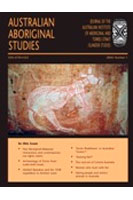Australian Aboriginal Studies: Issue 1, 2004
Abstracts for Issue 1, 2004
Aboriginal/Macassan interactions in the 18th and 19th century in northern Australia and contemporary sea rights claims
Denise Russell
The first native title claim to the seas under the Native Title Act was brought by the traditional owners of Croker Island in Northern Territory, Australia. This claim was partially successful. The High Court judgement on this case in 2001 resulted in the granting of non-exclusive sea rights. Exclusive rights were not granted as it was argued that the Croker Islanders had not asserted a right to exclude non-Aboriginal fishers in the past. This article looks at the basis for rejecting exclusive sea rights. Through an analysis of the complex relationships between Aboriginal and Makassan fishers in the eighteenth and nineteenth centuries, an argument is made that there could well be a basis in traditional practices for the granting of exclusive sea rights to some Aboriginal communities in the Northern Territory.
Archaeology of Torres Strait turtleshell masks: the Badu Island cache
Bruno David, Ian McNiven, William Bowie, Manuel Nomoa, Peo Ahmat, Joe Crouch, Liam Brady,Michael Quinnell and Anita Herle
Turtleshell masks are distinctive Torres Strait Islander objects that were used during ritual performances, and carefully curated, during ethnographic times. Yet the history of these rituals and their material expressions are poorly understood. The numerous instances of turtle shell masks collected during the nineteenth century and currently held in museum collections around the world, and the chance discovery of one such mask cached in a rock-shelter on the island of Badu, now allows for their historicising through a program of AMS radiocarbon dating. Initial results are reported.
Putting Herbert Basedow back in focus: the 1928 expedition to Arnhem Land
Murray Garde and Apolline Kohen-Raimondo
In 1928 ethnographer and geologist Herbert Basedow undertook a privately funded expedition through western Arnhem Land. The photographs he took on that trip constitute some of first photographic images of western Arnhem Land rock-art. In addition to his photographs, Basedow kept a field journal that reveals a relatively enlightened attitude towards Aboriginal art, considering the views commonly held by Europeans about Aboriginal peoples during this era. The rock-art sites Basedow recorded in 1928 remain sites of significance to the Kuninjku site custodians who have their own contemporary interpretations of the paintings photographed by Basedow some 75 years ago. Comparisons are presented between Basedow’s 1928 documentation and the contemporary Kuninjku view of these sites.
'Exotic Bradshaws' or Australian 'Gwion': an archaeological test
Michael Barry and J. Peter White
‘Bradshaw’, Aboriginal rock-art figures in the Kimberley, recently have become a focus of increased interest and publication. We discuss six recent pieces of work relevant to the suggestion that they are of exotic, rather than Australian origin. We present robust evidence of their Aboriginality.
'Stoning Fish?' A hitherto unrecorded class of stone artefact from the coastal Pilbara
Kim Akerman
Yodda-like stone artefacts from the coastal Pilbara region of Western Australia differ markedly from recorded yoddas and constitute a hitherto unrecorded Aboriginal Australian stone implement. I suggest that the implements were possibly used as missiles for killing or stunning fish.
Papers from Symposium B of AURA2000 Congress The rock-art of Central Australia: an overview
R. G. Gunn
Central Australia has long been recognised as containing a regionally distinct suite of rock-art; its character has, however, still to be adequately defined. The rock-art exhibits a range of techniques, with each technique having its own distinctive motif repertoire. Three techniques dominate: paintings, stencils and peckings. The paintings and peckings contain the greatest range of motif types with the paintings dominated by circles and other abstract elements (U-shapes, C-shapes, dots, bars), and macropod- and emu-track types. Peckings consist of three temporal sub-groups: early horizontal panels, intermediary vertical panels, and recent horizontal panels. The peckings are dominated by animal tracks, circles, lines and in some areas human figures with small numbers of large animals and anthropomorphs. Human hands dominate the stencils, with some object-stencils. The early pecked repertoire is fairly consistent across the region, while the later peckings and painted motifs tend to show a degree of variation with local concentrations of particular motif types. A distinction between the rock-art of the Arrandic and that of the Western Desert language areas is emerging. Limited evidence suggests a tentative chronology from the Pleistocene to the present.
'These things take time': Central Australian rock-art in context
June Ross and Leo Abbott
The continuing discussion about Indigenous perspectives and understandings of rock-art has implications for archaeological research, especially in Central Australia where rock-art is a significant part of Aboriginal life today. We present an Indigenous view of outcomes of research projects generally and an outline of a current collaborative rock-art study in Central Australia. We investigate the context in which rock-art was produced in order to develop an understanding of the relationship between the landscape, the motif assemblages and other past human activities.
Rock-art and the archaeological record of indigenous settlement in central Australia
Peter Thorley
This paper provides an overview of archaeological and radiocarbon evidence relevant to the interpretation of central Australian rock-art. Archaeological assemblages span a period of approximately 30 000 years that was anything but static. From a combination of archaeological and paleoenvironmental evidence it has been possible to identify trends in human occupation against a backdrop of fluctuating cycles of high and low rainfall. The implications of these trends are not limited to settlement structure and resource use but extend across all aspects of life including social organisation, ideology and symbolic expression.
